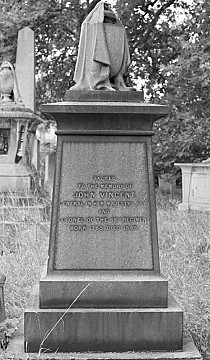Gen. John Vincent (1764-1848)
General John Vincent, of 117 Pall Mall, London; died unmarried
He was born at Limerick, Ireland, and was the brother of Arthur Vincent who lived at Summerhill in Co. Limerick. He was commissioned into the 66th Foot in 1781. He served in the West Indies and was at the taking of St. Domingo as a Captain with the 49th Foot in 1793. On the return home, he was captured by a French frigate and kept prisoner for a year. During the Napoleonic Wars, as a Major he served in the expeditions to Helder and Copenhagen under Admiral Sir Hyde Parker.
While stationed as a Lt.-Colonel in Upper Canada, he was promoted to Brigadier-General and given command of the Niagara Peninsula during the War of 1812-14 after the Americans attacked in 1813. He was defeated at the Battle of Fort George but was able to rebound and establish new lines at Burlington Heights overlooking Hamilton on the site of Dundurn Castle. He directed the campaign during the summer and fall that eventually forced the Americans to abandon the Niagara area in December, 1813, thanks in large part due to his victory at the Battle of Stoney Creek. Due to illness he was replaced by General Phineas Riall, though of the several officers of the 49th Regiment who reached high command during the War of 1812, Vincent was the longest-serving of them. British and Canadian accounts of the war give the impression of a modest, well-liked, and generous officer who gave whatever help he could to other commanders. He was promoted to Colonel of the 69th Regiment and from 1814 was given the sinecure post of Lieutenant-Governor of Dumbarton Castle. He died unmarried at his home in London, 117 Pall Mall.
While stationed as a Lt.-Colonel in Upper Canada, he was promoted to Brigadier-General and given command of the Niagara Peninsula during the War of 1812-14 after the Americans attacked in 1813. He was defeated at the Battle of Fort George but was able to rebound and establish new lines at Burlington Heights overlooking Hamilton on the site of Dundurn Castle. He directed the campaign during the summer and fall that eventually forced the Americans to abandon the Niagara area in December, 1813, thanks in large part due to his victory at the Battle of Stoney Creek. Due to illness he was replaced by General Phineas Riall, though of the several officers of the 49th Regiment who reached high command during the War of 1812, Vincent was the longest-serving of them. British and Canadian accounts of the war give the impression of a modest, well-liked, and generous officer who gave whatever help he could to other commanders. He was promoted to Colonel of the 69th Regiment and from 1814 was given the sinecure post of Lieutenant-Governor of Dumbarton Castle. He died unmarried at his home in London, 117 Pall Mall.


